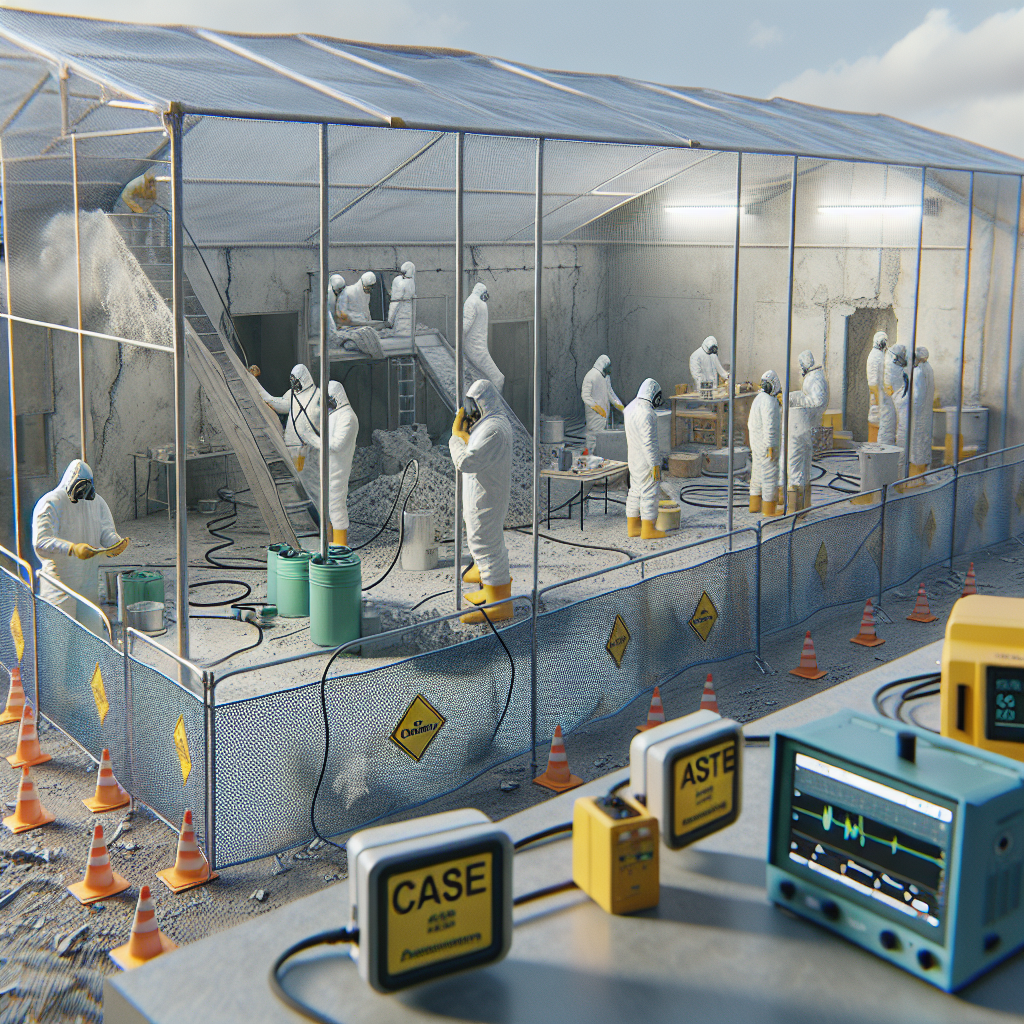
In urban environments, safeguarding community health is a top priority, especially when dealing with hazardous materials like asbestos.
This mineral, prized for its strength, poses severe health risks, including cancer and respiratory diseases, particularly in older structures where it is frequently found in insulation, flooring, and roofing materials.
Given these dangers, professional asbestos abatement is crucial. Attempting to manage this process alone can lead to mishandling, increasing health risks.
Trained specialists in asbestos removal are equipped to handle the associated hazards safely.
The remediation process commences with a thorough inspection and testing to confirm the presence of asbestos. Following this, effective preparation and containment strategies are essential for ensuring safe asbestos abatement and removal practices in Denver, adhering to guidelines set forth by the Occupational Safety and Health Administration and the United States Environmental Protection Agency to protect health and mitigate cancer risks associated with this hazardous mineral.
Click here to learn more about: asbestos
Understanding Asbestos Risks
The presence of harmful fibers in many aging structures poses a considerable challenge to public health. Building insulation, once heralded for its fire-resistant advantages, has left a legacy of serious health concerns.
Individuals exposed to these substances may find themselves at risk for diseases such as lung cancer and asbestosis.
Unfortunately, many remain unaware of the hidden dangers lurking within older homes or commercial buildings.
Construction materials, including drywall, can often contain these hazardous components, underscoring the need for heightened awareness. Regular inspections, coupled with a solid understanding of regulations, play a pivotal role in reducing these threats.
Implementing safe management practices is essential for protecting both workers and residents from potential harm associated with this dangerous material.

Safe Practices For Asbestos Removal
Handling materials that pose a significant risk to health requires meticulous planning and adherence to safety guidelines. Without proper precautions, exposure to hazardous substances can lead to severe long-term consequences, including respiratory diseases.
Implementing effective environmental remediation strategies is key to reducing these threats and safeguarding everyone involved.
Before initiating any work, it’s imperative to carry out comprehensive asbestos testing to ascertain the location and amount of the dangerous material.
A structured approach will help mitigate risks throughout the entire process, ensuring that each step is taken with the utmost care for individuals and the surrounding environment. Adequate sealing and disposal of the removed items are vital in preserving safety standards.
Handling Hazardous Materials
- Over 3 million workers in the U. S. are exposed to asbestos on the job.
- Asbestos exposure is linked to diseases such as asbestosis, lung cancer, and mesothelioma.
- Effective environmental remediation can reduce the risk of exposure by up to 90% when properly implemented.
- Proper sealing and disposal of hazardous materials are essential to prevent contamination of surrounding areas.
Importance Of Professional Inspections
Ensuring the safety and longevity of a property is paramount for any owner. Comprehensive evaluations help uncover concealed hazards, such as asbestos fibers, that could threaten both health and investment.
By hiring professional inspectors, individuals are empowered to pinpoint potential issues before they evolve into significant expenses.
These assessments are vital for adhering to local regulations and standards, which can differ greatly by region.
In Denver, for instance, asbestos removal services are essential in older structures where toxic materials might be lurking. Routine evaluations not only assist in preserving property value but also curtail long-term costs linked to unexpected repairs
Health Impacts Of Asbestos Exposure
The presence of hazardous materials in our environment can lead to devastating health consequences. When individuals are exposed to certain substances, particularly those found in older buildings like floor tile or drywall, they may develop serious respiratory conditions over time.
One of the most concerning effects includes the development of mesothelioma, a rare cancer that typically affects the lining of the lungs and is notoriously hard to treat.
Prolonged exposure to these toxic elements can cause asbestosis, a chronic lung disease marked by significant scarring and breathing difficulties.
Statistics indicate that the risk of lung cancer increases dramatically, especially for those who smoke and are also exposed to these harmful agents. Populations such as construction workers are particularly at risk due to their regular contact with materials that contains asbestos.
Implementing effective asbestos inspection and professional abatement services is essential to safeguard health and prevent long-term complications.
Guidelines For Asbestos Abatement
Addressing hazardous materials in your environment is crucial for safeguarding health and ensuring safety. Understanding the presence of harmful substances, such as those often found in older buildings, is essential for homeowners.
A detailed inspection serves as the foundation for an effective management plan, allowing you to mitigate exposure effectively.
Engaging a qualified company to perform asbestos removal guarantees compliance with regulations established by OSHA.
Air quality testing following the mitigation process is vital to confirm that the environment is safe for habitation. By adhering to these key practices, you can achieve peace of mind knowing you have prioritized a secure living space.
Managing Asbestos In Older Buildings
The presence of hazardous materials in older structures can pose serious challenges for property owners and occupants. Buildings erected prior to the 1980s may still contain a variety of building materials that can release harmful particles into the air.
Among these, certain ceiling tiles have been identified as potential sources of asbestos dust, which can lead to severe health issues.
To ensure safety, homeowners should prioritize the importance of conducting asbestos inspections with licensed asbestos professionals.
This proactive approach can help identify any latent dangers and facilitate the creation of a comprehensive management strategy. Adhering to local regulations is critical, as these often require engaging certified remediation services for any necessary removal or maintenance tasks.
To maintain a safe environment, regular monitoring of identified materials is essential in minimizing asbestos exposure risks. Residents in the Denver metro area can turn to the department of public health for valuable resources that assist homeowners in conducting asbestos inspections, provide guidance on removing friable asbestos from a variety of building types, and offer comprehensive asbestos abatement services to minimize exposure to asbestos dust every step of the way.
Asbestos Safety
- Buildings constructed before the 1980s may contain hazardous materials like asbestos.
- Asbestos exposure can lead to severe health issues, including respiratory diseases and cancer.
- Engaging licensed asbestos professionals for inspections is crucial for identifying potential risks.
- Local regulations often mandate the use of certified services for asbestos removal and management.
Compliance With Osha Regulations
Creating a secure environment is a critical responsibility for employers, especially in settings involving hazardous materials. Adhering to established guidelines is essential for ensuring worker safety and health.
The regulations set forth by the governing body dictate best practices for the handling of construction materials and other potentially dangerous substances.
Employers must undertake rigorous assessments with great care, ensuring that their workforce is shielded from exposure to harmful agents like fibrous asbestos.
Consistent training and thorough inspections are vital to maintain standards and foster a culture of safety.
Noncompliance can result in significant legal repercussions, adversely affecting both worker health and the reputation of the business.
Steps For Effective Remediation
Establishing a safe environment is a fundamental priority for any property owner, whether in a residential or commercial setting. The first step involves an Initial Assessment, where a thorough evaluation of the property is conducted.
Hiring qualified professionals who have dealt with properly identifying contamination sources is critical for timely action.
Next, accurate Documentation is a must.
It’s vital to document all findings and create a comprehensive remediation plan, ensuring compliance with local regulations that are necessary for successful outcomes.
The level of customer service provided during this phase can significantly impact the overall effectiveness.
When Choosing a Remediation Method, evaluate various techniques used in a variety of building construction scenarios. Select a method that minimizes disruption and ensures safety for all occupants, particularly when dealing with asbestos-containing materials in various building construction types, as the mission to provide exceptional customer service is exemplified by the highly recommended company that went out of their way to take great care while working on both home and commercial projects, including single-family residential dwellings covering 32 square feet.
Asbestos Removal Cost In Denver – Real Stories
Safe Asbestos Disposal In Denver – Unique Home Safety Insights